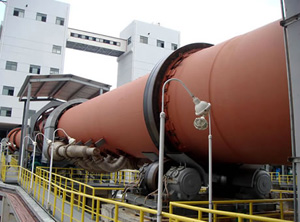- PRODUCT CENTER
- Stone crushing machine
- Sand making machine
- Powder making machine
- Ore dressing machine
- Cement Production Line
- Tel: 0086-371-67833171
- E-mail: machine@hxjq.com

Rotary Kiln
Rotary kilns are used to heat solids to the point where a required chemical reaction(s) takes place. The rotary kiln is basically a rotating inclined cylinder. Rotary kiln is the main equipment of calcining cement clinker. It has simple structure, easy operation in producing, less wearing parts and high efficiency.
- Features
- Technical Data
Overview Of Rotary Kiln
Rotary kilns are used to heat solids to the point where a required chemical reaction(s) takes place. The rotary kiln is basically a rotating inclined cylinder. Rotary kiln is the main equipment used for calcining the cement clinker. It has many advantages such as simply structure, easy operation, less wearing parts and high efficiency. It is used in the cement plant for calicle high grade cement and at the same time it can be used in metallurgy, chemical and construction, etc.

Superiorities Of Hongxing Revolving Kiln
Our revolving kiln system is developed with the most advanced hydraulic gear wheel device, the metering piston pump of high precision, the high precision control valve and contact graphite block sealing devices and other advanced technologies. Compared with the equipment with the same specification, Hongxing rotary kiln can stabilize the thermal system program and improve the equipment operation rate, with the operation rate increased by 10%, the yield increased by 5% -10% and heat consumption reduced by 15%.
Working Principle Of Rotating Kiln
The kiln is a cylindrical vessel, inclined slightly to the horizontal, which is rotated slowly around its axis. The material to be processed is fed into the upper end of the cylinder. As the kiln rotates, the materials gradually move down towards the lower end, and may undergo a certain amount of stirring and mixing. Hot gases pass along the kiln sometimes in the same direction as the process material (co-current), but usually in the opposite direction (counter-current). The hot gases may be generated in an external furnace, or may be generated by a flame inside the kiln. Such a flame is projected from a burner-pipe (or 'firing pipe') which acts like a large burner. The fuel may be gas, oil or pulverized coal.
Contents Of Common Process Measurements
1) Hot Clinker Detection
2) Product Discharge Temperature
3) Product Entry Temperature
4) Mid-Zone Temperature
5) Combustion Gas Temperature
6) Kiln Shell Hot Spot Detection
| Product Specification (m) |
Kiln dimensions | Motor power (kw) |
note | ||||
| Diameter (m) |
Length (m) |
Obliquity (%) |
Capacity (t/d) |
Rotation speed (r/min) |
|||
| Φ2.5×40 | 2.5 | 40 | 3.5 | 180 | 0.44-2.44 | 55 | ----- |
| Φ2.5×50 | 2.5 | 50 | 3 | 200 | 0.62-1.86 | 55 | ----- |
| Φ2.5×54 | 2.5 | 54 | 3.5 | 280 | 0.48-1.45 | 55 | outside disassemble kiln |
| Φ2.7×42 | 2.7 | 42 | 3.5 | 320 | 0.10-1.52 | 55 | ------ |
| Φ2.8×44 | 2.8 | 44 | 3.5 | 450 | 0.437-2.18 | 55 | outside disassemble kiln |
| Φ3.0×45 | 3 | 45 | 3.5 | 500 | 0.5-2.47 | 75 | ------ |
| Φ3.0×48 | 3 | 48 | 3.5 | 700 | 0.6-3.48 | 100 | outside disassemble klin |
| Φ3.0×60 | 3 | 60 | 3.5 | 800 | 0.3-2 | 100 | ------ |
| Φ3.2×50 | 3.5 | 50 | 4 | 1000 | 0.6-3 | 125 | outside disassemble klin |
| Φ3.3×52 | 3.3 | 52 | 3.5 | 1300 | 0.266-2.66 | 125 | kiln with preheater precalcine |
| Φ3.5×54 | 3.5 | 54 | 3.5 | 1500 | 0.55-3.4 | 220 | |
| Φ3.6×70 | 3.6 | 70 | 3.5 | 1800 | 0.25-1.25 | 125 | |
| Φ4.0×56 | 4 | 56 | 4 | 2300 | 0.41-4.07 | 315 | |
| Φ4.0×60 | 4 | 60 | 3.5 | 2500 | 0.396-3.96 | 315 | |
| Φ4.2×60 | 4.2 | 60 | 4 | 2750 | 0.41-4.07 | 375 | |
| Φ4.3×60 | 4.3 | 60 | 3.5 | 3200 | 0.396-3.96 | 375 | |
| Φ4.5×66 | 4.5 | 66 | 3.5 | 4000 | 0.41-4.1 | 560 | |
| Φ4.7×74 | 4.7 | 74 | 4 | 4500 | 0.35-4 | 630 | |
| Φ4.8×74 | 4.8 | 74 | 4 | 5000 | 0.396-3.96 | 630 | |
| Φ5.0×74 | 5 | 74 | 4 | 6000 | 0.35-4 | 710 | |
| Φ5.6×87 | 5.6 | 87 | 4 | 8000 | Max4.23 | 800 | |
| Φ6.0×95 | 6 | 95 | 4 | 10000 | Max5 | 950×2 | |
- Leave A Message


